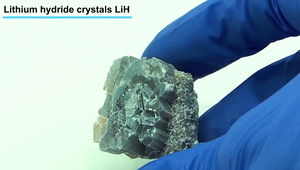Difference between revisions of "Lithium hydride"
| Line 7: | Line 7: | ||
| OtherNames = Lithium monohydride | | OtherNames = Lithium monohydride | ||
<!-- Images --> | <!-- Images --> | ||
| − | | ImageFile = | + | | ImageFile = Lithium hydride crystal by ChemicalForce.jpg |
| − | | ImageSize = | + | | ImageSize = 300 |
| ImageAlt = | | ImageAlt = | ||
| ImageName = | | ImageName = | ||
| + | | ImageCaption = Crystallized LiH. It's blue not because of the reflection of the glove color, but because lithium hydride turns blue as it ages. | ||
| ImageFile1 = | | ImageFile1 = | ||
| ImageSize1 = | | ImageSize1 = | ||
Revision as of 13:01, 3 November 2019
 Crystallized LiH. It's blue not because of the reflection of the glove color, but because lithium hydride turns blue as it ages.
| |
| Names | |
|---|---|
| IUPAC name
Lithium hydride
| |
| Other names
Lithium monohydride
| |
| Properties | |
| LiH | |
| Molar mass | 7.95 g/mol |
| Appearance | White or light gray samples |
| Odor | Odorless |
| Density | 0.78 g/cm3 |
| Melting point | 688.7 °C (1,271.7 °F; 961.9 K) |
| Boiling point | 900 °C (1,650 °F; 1,170 K) (decomposes) |
| Reacts | |
| Solubility | Reacts with alcohols, aldehydes, amines, ammonia, carboxylic acids, DMSO, esters, ethers, halocarbons, ketones Soluble in molten lithium borohydride, lithium fluoride and sodium hydride Slightly soluble in dimethylformamide Insoluble in hydrocarbons |
| Vapor pressure | ~0 mmHg |
| Thermochemistry | |
| Std molar
entropy (S |
170.8 J·mol-1K-1 |
| Std enthalpy of
formation (ΔfH |
-90.65 kJ/mol |
| Hazards | |
| Safety data sheet | Sigma-Aldrich |
| Related compounds | |
| Related compounds
|
Sodium hydride Calcium hydride |
| Except where otherwise noted, data are given for materials in their standard state (at 25 °C [77 °F], 100 kPa). | |
| Infobox references | |
Lithium hydride is an inorganic compound with the formula LiH.
Contents
Properties
Chemical
Lithium hydride reacts with water to release hydrogen.
- LiH + H2O → LiOH + H2
Physical
Lithium hydride is an odorless white or slight grayish solid, which reacts with most solvents and is insoluble in those with which it doesn't react, like hydrocarbons.
Availability
Lithium hydride is sold by chemical suppliers, though it's not cheap, and it's hard to find.
On Alibaba one can find many sellers selling what is described as "lihium hydride", but be very careful if you want to purchase the product from there, since most of the prices listed for this compound are very low, which may be suspicious, since lithium compounds aren't cheap, let alone a hydrogen-rich and potentially pyrophoric powdered lithium compound.
Preparation
Can be prepared by reacting molten lithium metal with hydrogen. The reaction takes place in a nickel crucible, between 450-500 °C, and the hydrogen used must be air and water-free. The yield of this reaction is 95%.[1]
However, the reaction can proceed at temperatures as low as 29 °C. The yield is 60% at 99 °C and 85% at 125 °C, and the rate depends significantly on the surface condition of LiH and the purity of the inert gas used as inert conditions.
Hydrogenolysis of n-butyllithium at normal temperature and atmospheric pressure in the absence of catalyst will yield LiH.[2]
Projects
- Desiccant
- Make lithium aluminium hydride
Handling
Safety
Lithium hydride is very reactive towards most common solvents, it will even slowly attack ethers. It may spontaneously ignite in moist air.
Storage
Lithium hydride must be kept in air-tight containers, in an inert atmosphere, away from moisture. Schlenk flasks are good storage containers.
Disposal
Lithium hydride can be safely neutralized by slowly adding it in a large volume of alcohol, followed by slow addition of water.
References
- ↑ Brandt, P.; Acta Chemica Scandinavica (1947-1973); vol. 3; (1949); p. 1050 - 1057
- ↑ Gilman, H.; Jacoby, A. L.; Ludeman, H.; Journal of the American Chemical Society; vol. 60; (1938); p. 2336 - 2338
Relevant Sciencemadness threads
- Articles containing unverified chemical infoboxes
- Chemical compounds
- Inorganic compounds
- Lithium compounds
- Hydrogen compounds
- Metal hydrides
- Bases
- Insoluble compounds
- Reducing agents
- Desiccants
- Materials unstable in acidic solution
- Materials that react with water
- Irritants
- Air-sensitive materials
- Pyrophoric materials